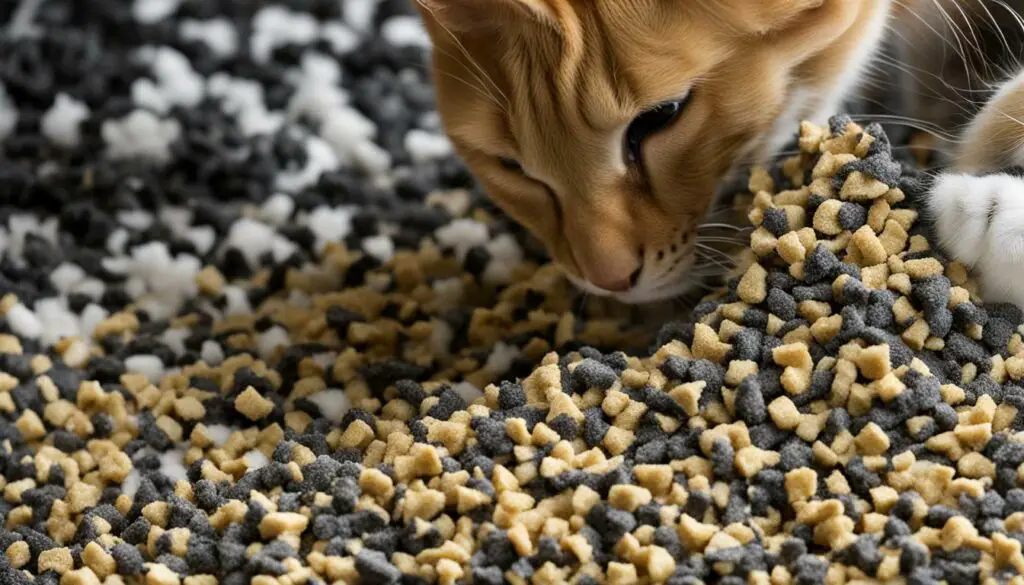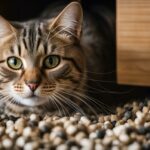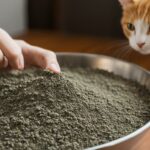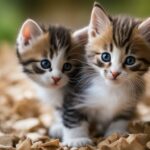Deciding on the right type of cat litter for your feline friend can be a perplexing task. With the myriad of options available, it’s essential to understand the intricacies of clumping and non-clumping cat litter to make an informed decision. In this article, I will compare the pros and cons of clumping and non-clumping cat litter, helping you navigate through the complexities and choose what’s best for your beloved pet.
Key Takeaways:
- Clumping cat litter forms solid clumps when in contact with moisture, making cleanup easier.
- Non-clumping cat litter requires less maintenance but may need more frequent complete changes.
- Consider factors such as granule type, odor control, dust-free properties, tracking, and environmental impact when choosing cat litter.
- Both clumping and non-clumping litters can offer effective odor control, but using different mechanisms.
- Take into account your cat’s preferences, any sensitivities or allergies, and your own cleaning routine when deciding on the litter type.
The Advantages of Clumping Cat Litter
When it comes to cat litter, clumping varieties offer several advantages that make them a popular choice among cat owners. The unique properties of clumping cat litter, such as the quality of its granules, absorbency, odor control, easy cleanup, and longevity, make it a convenient and efficient option for maintaining a clean litter box environment.
One of the key benefits of clumping cat litter is its ability to form solid clumps when it comes into contact with moisture. This makes it incredibly easy to scoop out and remove solid waste from the litter box. The granules in clumping litter are highly absorbent, effectively controlling odors and ensuring a fresh-smelling litter box. This absorbency also contributes to the litter’s long-lasting nature, making it a cost-effective choice for cat owners.
Moreover, clumping cat litter’s easy cleanup is a significant advantage. The solid clumps formed by this type of litter allows for quick and efficient removal of waste, minimizing the time and effort required to maintain a clean litter box. This convenience factor is particularly appealing to busy cat owners who want to ensure good hygiene without spending excessive time on litter box maintenance.
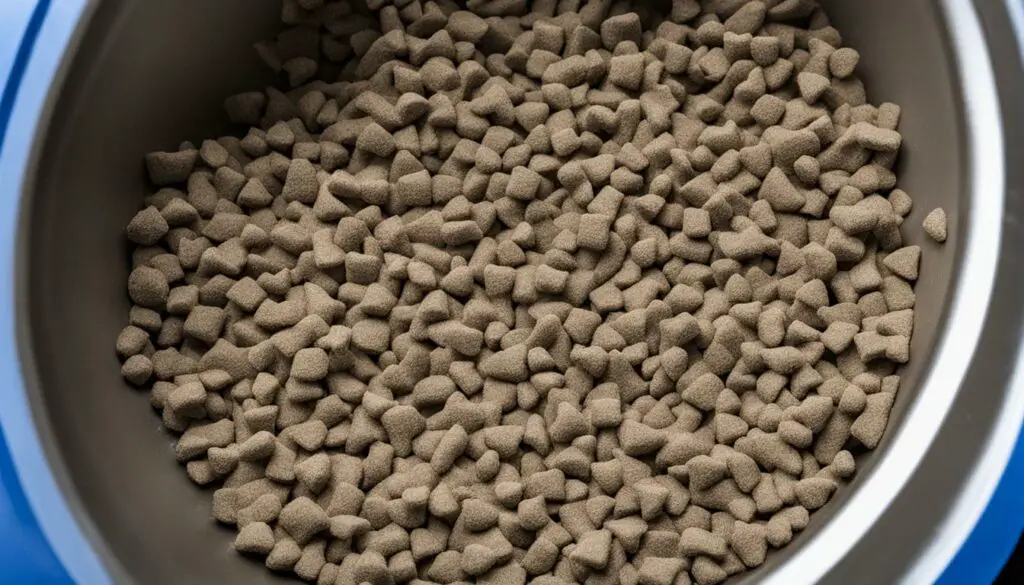
In summary, the advantages of clumping cat litter lie in its granules, absorbent properties, odor control, easy cleanup, and long-lasting nature. By considering these benefits, cat owners can make an informed decision and provide their feline friends with a litter box experience that is convenient, comfortable, and odor-free.
The Benefits of Non-Clumping Cat Litter
When it comes to cat litter options, non-clumping cat litter offers a range of benefits for both cat owners and their furry friends. Made from natural materials such as clay, silica gel, wood pellets, or recycled paper, non-clumping litter provides a low-maintenance solution that is both effective and environmentally friendly.
One of the key advantages of non-clumping cat litter is its low maintenance requirements. Unlike clumping litter that forms solid clumps when it comes into contact with moisture, non-clumping litter does not clump together. This means it does not need to be scooped as frequently, making it a convenient choice for busy cat owners.
However, it’s important to note that non-clumping litter may require more frequent complete changes compared to clumping alternatives. This is because without the solid clumps, bacterial growth and odor can become more pronounced. Regular monitoring and complete changes of non-clumping litter will help maintain a clean and odor-free litter box environment.
| Benefits of Non-Clumping Cat Litter |
|---|
| Natural Materials |
| Low Maintenance |
| Bacterial Growth Control |
| Environmentally Friendly |
Overall, non-clumping cat litter provides a viable option for cat owners looking for a natural, low-maintenance solution. By considering the needs of both their cats and the environment, cat owners can make an informed decision that promotes a clean and comfortable litter box experience for their feline friends.
Choosing the Right Type of Cat Litter
When it comes to choosing the right type of cat litter, cat owners have a variety of options to consider. Two popular choices are clumping cat litter and non-clumping cat litter. Each type offers its own set of advantages and considerations. Let’s take a closer look at the differences between clumping and non-clumping cat litter to help you make an informed decision for your feline friend.
Clumping cat litter, often made from synthetic materials such as clay or silica gel, forms solid clumps when it comes into contact with moisture. This makes it easy to scoop out and remove solid waste, resulting in convenient cleanup. Synthetic clumping litters are known for their excellent absorbency and odor control properties, ensuring a fresh-smelling litter box. On the other hand, non-clumping cat litter is often made from natural materials like wood pellets or recycled paper. While it may require more frequent complete changes to prevent bacterial growth and control odor, non-clumping litter offers a low-maintenance option for cat owners.
When deciding between synthetic clumping and natural non-clumping cat litter, consider factors such as your cat’s preferences, your cleaning routine, and any environmental concerns. Synthetic clumping litter, with its superior clumping and odor control capabilities, may be a good choice if convenience is a top priority for you. However, if you prefer a more eco-friendly option or your cat has sensitivities to certain materials, natural non-clumping litter made from wood pellets or recycled paper may be worth considering.
Ultimately, the right type of cat litter depends on your individual cat’s needs and your own preferences. It’s important to choose a litter that provides comfort and promotes consistent litter box usage. Consider the factors discussed and make an informed decision that ensures a clean and comfortable litter box experience for both you and your feline companion.
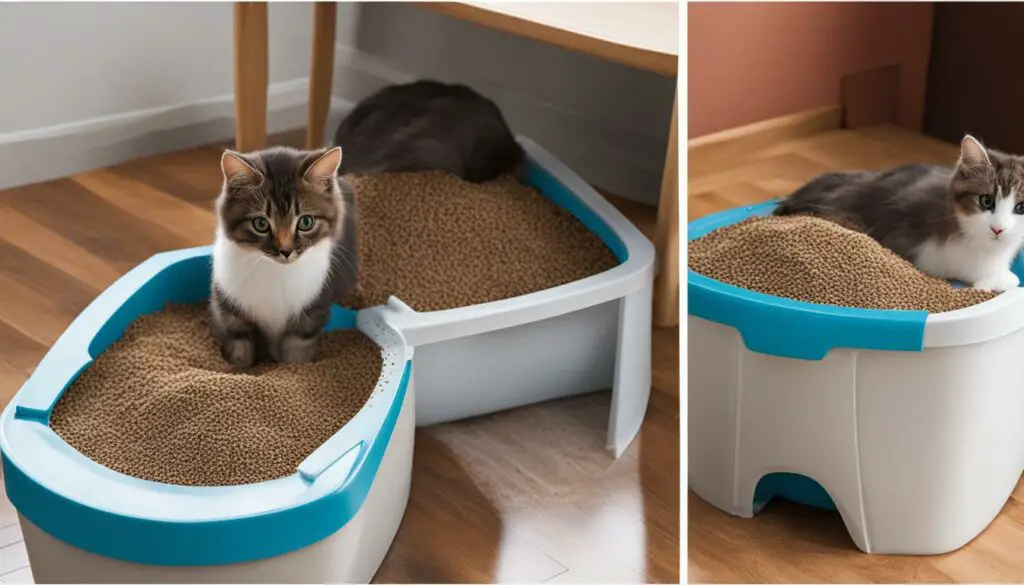
Table: Comparative Overview of Clumping and Non-Clumping Cat Litter
| Clumping Cat Litter | Non-Clumping Cat Litter |
|---|---|
| Forms solid clumps for easy waste removal | Does not form clumps; requires more frequent complete changes |
| Excellent absorbency and odor control | May require additional odor control measures |
| Long-lasting and cost-effective | May need more frequent replacements |
| Made from synthetic materials like clay or silica gel | Often made from natural materials like wood pellets or recycled paper |
| Convenient for cat owners with busy schedules | A more eco-friendly option |
Table: Comparative overview of the characteristics and considerations of clumping and non-clumping cat litter.
Considerations for Odor Control
When it comes to choosing between clumping and non-clumping cat litter, odor control is one of the crucial factors to consider. Both types of litter offer different approaches to tackle unpleasant smells in your cat’s litter box.
Clumping cat litter, with its ability to form solid clumps, helps to encapsulate odor-causing substances such as ammonia from urine and bacteria from feces. These solid clumps can be easily scooped out, effectively reducing the presence of odor in the litter box.
On the other hand, non-clumping cat litter may rely on antimicrobial properties to combat bacterial and fungal growth that can contribute to odor. By minimizing the growth of odor-causing microorganisms, non-clumping litter helps to maintain a fresher-smelling litter box.
“The odor control abilities of clumping and non-clumping cat litters depend on different mechanisms, but both types can effectively help in keeping your home smelling fresh.”
Bacterial Growth and Fungal Growth
Beyond odor control, it is important to consider the potential for bacterial and fungal growth in your cat’s litter box. Bacteria and fungi thrive in damp environments, and the moisture content can vary depending on the type of litter.
Clumping cat litter, with its ability to form solid clumps, helps to minimize the spread of moisture and reduce the growth of bacteria and fungi. The solid clumps act as a barrier, preventing moisture from reaching the bottom layers of litter where bacterial and fungal growth can occur.
Non-clumping cat litter may have antimicrobial properties that help inhibit the growth of bacteria and fungi. These properties can be particularly beneficial in controlling odor and reducing the risk of bacterial and fungal infections.
| Clumping Cat Litter | Non-Clumping Cat Litter | |
|---|---|---|
| Bacterial Growth | Minimized due to solid clumps | Inhibited by antimicrobial properties |
| Fungal Growth | Reduced due to solid clumps | Inhibited by antimicrobial properties |
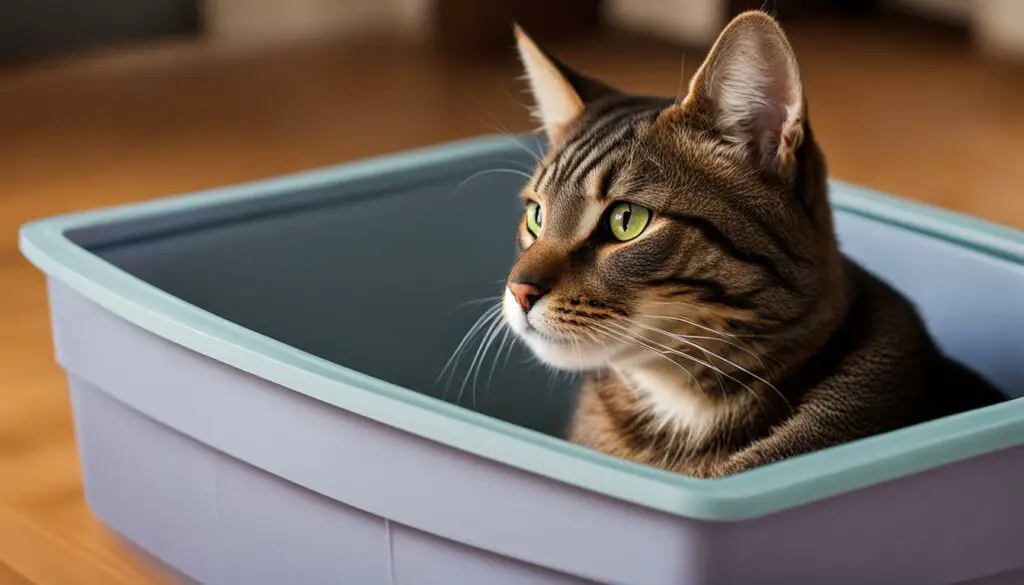
Remember, both clumping and non-clumping cat litters can effectively control odor in their own ways. Consider your cat’s litter box habits, your preferences, and any specific odor concerns when choosing the type of litter that works best for you and your feline companion.
Tracking and Dust-Free Options
When it comes to choosing between clumping and non-clumping cat litter, one important aspect to consider is tracking. Tracking refers to the litter granules that may stick to your cat’s paws and be carried outside the litter box. Both clumping and non-clumping litters can have options for low tracking, but there are a few differences to keep in mind.
If you prefer a litter with minimal tracking, synthetic options like clay or silica gel tend to be a good choice. These granules are designed to be larger and heavier, reducing the likelihood of them being carried around the house. Synthetic litters often have smoother surfaces that are less likely to stick to your cat’s paws, resulting in less tracking overall.
On the other hand, if you prefer a more natural option, there are low tracking alternatives available as well. Natural litters made from materials like wood pellets or recycled paper can provide a dust-free and low tracking experience. These litters are often designed to be larger in size, making them less likely to be tracked outside the litter box. Additionally, natural litters tend to be lighter in weight compared to synthetic options, which can also contribute to less tracking.
![]()
Ultimately, the decision between synthetic and natural options for tracking and dust-free properties will depend on your personal preferences and your cat’s needs. Consider the factors that are most important to you, such as low tracking, dust-free properties, and the overall litter box experience. By choosing the right litter, you can create a more tidy and enjoyable environment for both you and your feline friend.
Environmental Considerations
When it comes to choosing cat litter, it’s important to consider the environmental impact of different options. Many cat owners are looking for environmentally friendly or eco-friendly alternatives that are biodegradable or flushable, helping to reduce waste and minimize their carbon footprint. By opting for cat litter that is more sustainable, we can make a positive impact on the environment.
There are a variety of environmentally friendly cat litters available on the market. These litters are often made from natural materials such as corn, wheat, pine, coconut, or grass, which are renewable resources. They provide a greener option compared to synthetic litters, which are typically made from clay or silica gel. By choosing a biodegradable or natural cat litter, you can help reduce the amount of waste that ends up in landfills.
Benefits of Environmental Cat Litters
One of the key benefits of using an environmentally friendly cat litter is that it can be biodegradable. This means that it will break down naturally over time, reducing the impact on the environment. Some biodegradable litters can even be composted, further reducing waste. Flushable cat litters are also available, allowing you to dispose of waste in an environmentally responsible way.
Another advantage of environmentally friendly litters is that they are often made from natural materials, which can be safer for cats and humans. Synthetic litters may contain chemicals or additives that can be harmful when ingested or inhaled. By choosing a natural litter, you can minimize the risk of exposure to these potentially harmful substances.
Overall, considering the environmental impact of the cat litter you choose is an important step towards creating a more sustainable and eco-friendly home for both you and your feline friend.
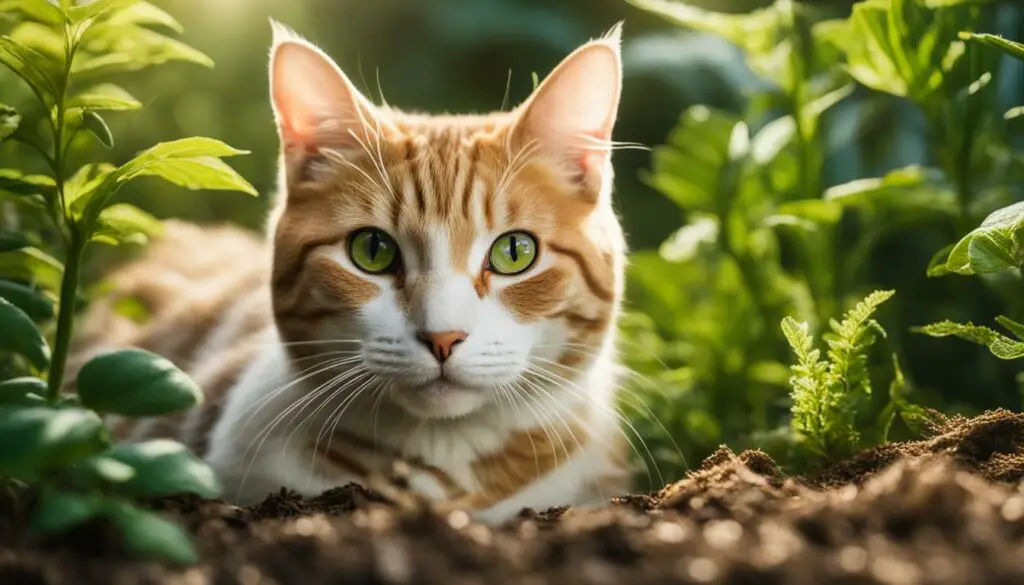
Catering to Sensitive Cats
When it comes to choosing the right cat litter, it’s essential to consider the unique needs of your feline friend, especially if they have sensitivities or allergies. Some cats are more sensitive to certain scents or materials used in cat litter, which can lead to respiratory issues or skin irritations. To provide a safe and comfortable environment for your sensitive cat, there are a few factors to keep in mind.
Choosing Scent-Free or Hypoallergenic Options
Scented cat litters may contain artificial fragrances that can be overwhelming for sensitive cats. It’s best to opt for unscented or hypoallergenic cat litter options, as they are formulated without added perfumes or dyes. These litters are designed to minimize the risk of triggering allergic reactions and provide a gentle and odor-neutralizing solution for your sensitive cat.
The Importance of Dust-Free Litter
Dust can be a major irritant for cats with respiratory issues or sensitivities. Look for cat litters that are specifically labeled as dust-free, as they are designed to minimize airborne particles that can cause discomfort or breathing difficulties. Dust-free cat litters can help create a healthier environment for your sensitive cat and reduce the risk of respiratory issues.
Monitoring Your Cat’s Reaction
Introduce any new cat litter gradually and monitor your cat’s reaction closely. If you notice any signs of discomfort, such as excessive scratching, sneezing, or respiratory distress, it may be an indication that the litter is not suitable for your cat. In such cases, consult with your veterinarian to determine an appropriate alternative that accommodates your cat’s sensitivities while still providing effective waste management.
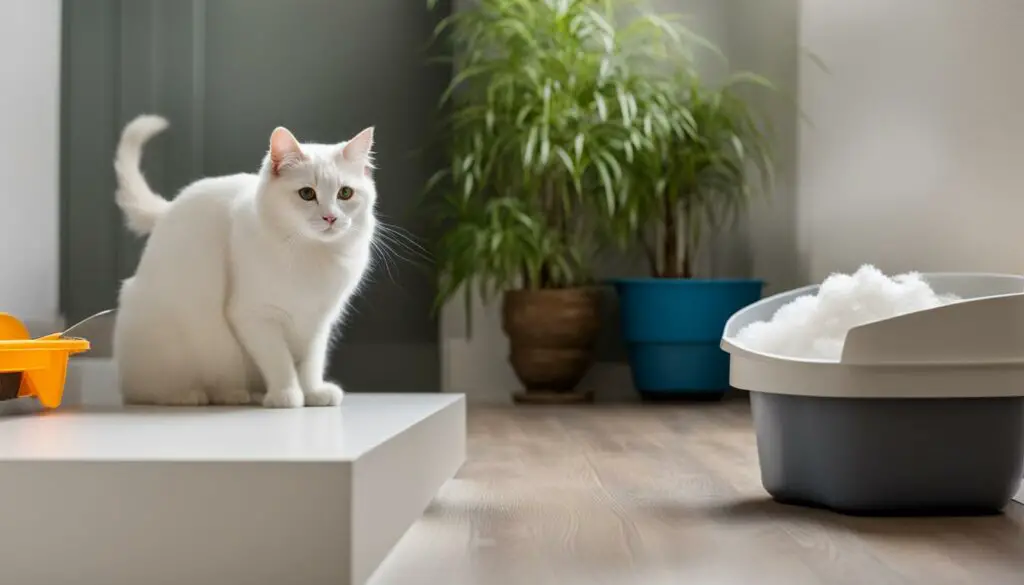
Remember, every cat is unique, and what works for one may not work for another. Taking the time to understand your cat’s individual needs and preferences is key to choosing the right litter that promotes their comfort and well-being. With the right litter choice, you can create a clean and inviting litter box environment that your sensitive cat will appreciate.
The Challenges of Urine and Feces Management
When it comes to managing urine and feces in the litter box, the choice between clumping and non-clumping cat litter plays a crucial role. Both options have their strengths and considerations to keep in mind.
Clumping Cat Litter: Clumping cat litter excels in handling urine. It forms solid clumps that are easy to scoop out, effectively containing and minimizing odor. The clumping action helps in isolating liquid waste and preventing it from spreading throughout the litter box. This makes cleaning and maintenance more convenient, as you can quickly remove the clumps without disturbing the rest of the litter.
Non-Clumping Cat Litter: Non-clumping litter, on the other hand, requires a slightly different approach. Since it doesn’t form clumps, you may need to scoop the litter more frequently to manage both urine and feces efficiently. Without the clumping action, the litter may become saturated with moisture, leading to a higher chance of odor and bacterial growth if not maintained properly. Regularly replacing the litter entirely can help address these concerns.
Comparing Clumping and Non-Clumping Cat Litter for Urine and Feces Management
Here is a comparison table highlighting the key differences between clumping and non-clumping cat litter for urine and feces management:
| Aspect | Clumping Cat Litter | Non-Clumping Cat Litter |
|---|---|---|
| Urine Management | Forms solid clumps for easy removal | Requires more frequent scooping |
| Feces Management | Efficient removal along with urine clumps | Needs regular scooping to maintain cleanliness |
| Odor Control | Effective due to quick clumping action | Requires proper maintenance and frequent litter changes |
| Moisture Absorption | Helps isolate and control liquid waste | Saturation can lead to odor and bacterial growth |
Consider your cat’s waste habits and your desired maintenance routine when choosing between clumping and non-clumping cat litter. Clumping litter provides convenient urine and feces management, making it easier to keep the litter box clean. Non-clumping litter demands more frequent attention but can still provide a functional solution if properly maintained. Ensure you monitor the litter box regularly and make adjustments as needed to maintain a hygienic and comfortable environment for your feline friend.
Long-Term Considerations
When choosing between clumping and non-clumping cat litter, it’s important to consider the long-term implications. Each type of litter has its own advantages and considerations regarding its longevity and overall effectiveness in managing solid waste and preventing bacterial growth.
Clumping cat litter is known for its long-lasting properties. The granules in clumping litter are designed to absorb moisture and form solid clumps, making it easy to remove solid waste. This clumping action not only allows for convenient cleanup but also helps to control odors effectively. Due to its ability to form clumps, clumping litter tends to last longer before needing a complete change. This can be a cost-effective option for cat owners, as it reduces the frequency of litter replacements.
On the other hand, non-clumping cat litter may require more frequent changes to maintain a clean and odor-free litter box. Without the ability to form clumps, non-clumping litter relies on regular scooping to manage solid waste and maintain cleanliness. This may involve more hands-on maintenance and a higher frequency of litter box cleaning. However, with proper care and maintenance, non-clumping litter can still provide an effective solution for managing solid waste and promoting good litter box hygiene.
| Clumping Cat Litter | Non-Clumping Cat Litter | |
|---|---|---|
| Longevity | Long-lasting, requires less frequent complete changes | May require more frequent changes |
| Bacterial Growth | Clumping action helps prevent bacterial growth | Regular scooping necessary to prevent bacterial growth |
| Solid Waste Management | Forms solid clumps for easy removal | Regular scooping required for effective waste management |
Ultimately, the choice between clumping and non-clumping cat litter depends on your preferences, your cat’s needs, and your desired level of maintenance. Consider the trade-offs between convenience and frequency of litter changes, as well as the overall effectiveness in managing solid waste and preventing bacterial growth. By understanding the long-term considerations, you can make an informed decision that promotes a clean and comfortable litter box experience for both you and your feline friend.
Weighing the Pros and Cons of Clumping vs Non-Clumping Cat Litter
When it comes to choosing the right cat litter for your feline friend, there are two main options to consider: clumping and non-clumping. Each type has its own set of advantages and disadvantages that can impact your decision-making process. To help you make an informed choice, let’s explore the pros and cons of clumping and non-clumping cat litter.
Pros of Clumping Cat Litter:
- Easy Cleanup: Clumping cat litter forms solid clumps when it comes into contact with moisture, making it a breeze to scoop out and remove solid waste.
- Odor Control: The highly absorbent granules in clumping litter help to effectively control odors, keeping your home smelling fresh and clean.
- Long-lasting: Clumping litter tends to last longer than non-clumping alternatives, providing a cost-effective solution for cat owners.
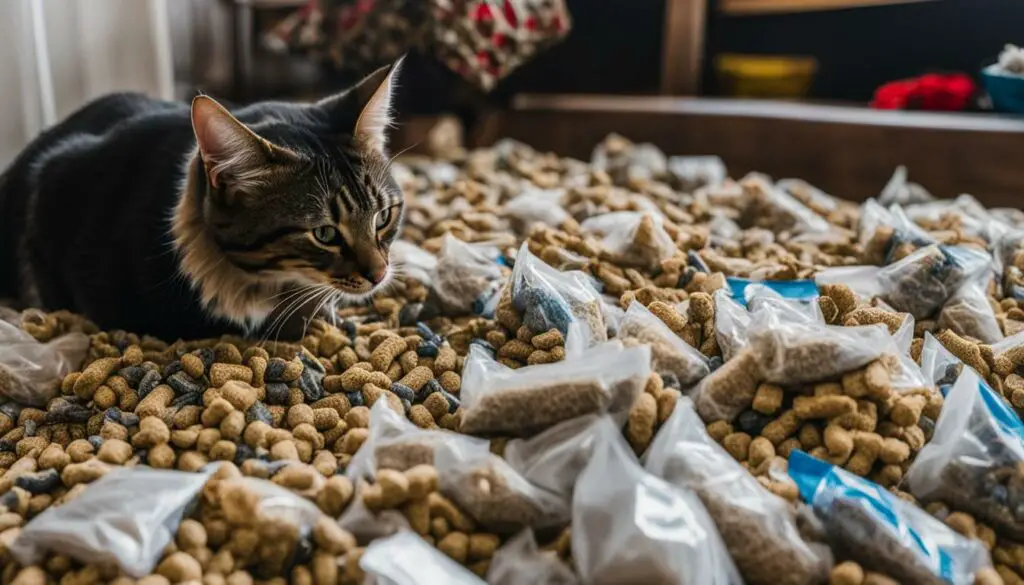
Pros of Non-Clumping Cat Litter:
- Natural Options: Non-clumping cat litter is often made from natural materials like clay, silica gel, wood pellets, or recycled paper, making it a more environmentally friendly choice.
- Low Maintenance: Non-clumping litter does not form clumps, so it requires less frequent scooping. However, complete changes may be needed more often to prevent bacterial growth and control odor.
By weighing the pros and cons of clumping and non-clumping cat litter, you can make a decision that aligns with your cat’s needs and your own lifestyle. Consider factors such as cleaning convenience, odor control, environmental impact, and your cat’s preferences to ensure a comfortable and hygienic litter box experience.
Making the Right Choice for Your Cat
When it comes to choosing between clumping and non-clumping cat litter, it’s important to consider your cat’s individual needs and preferences. Every cat is unique, and what works for one may not work for another. By understanding your cat’s litter box habits, health considerations, and environmental impact, you can make an informed decision that promotes your cat’s comfort and encourages consistent litter box usage.
Take into account any specific considerations such as allergies, respiratory issues, or sensitivities to scents or materials. Cats with allergies or respiratory issues may benefit from hypoallergenic options, both clumping and non-clumping. Additionally, consider your cat’s waste habits and your desired level of maintenance. Clumping litter is particularly effective at managing urine, while non-clumping litters may require more frequent scooping to manage both urine and feces efficiently.
It’s also worth considering your own lifestyle and cleaning routine when choosing the right cat litter. Clumping litter tends to last longer before needing a complete change, making it a convenient option for busy cat owners. Non-clumping litter, on the other hand, may require more frequent complete changes to prevent bacterial growth and control odor. Evaluate the pros and cons of each type of litter, keeping in mind factors such as cleaning convenience, odor control, and environmental impact.
By carefully considering your cat’s individual needs, preferences, and any specific considerations, you can make the right choice for your cat. A litter that keeps your cat comfortable, promotes good litter box hygiene, and aligns with your lifestyle is the key to a happy and healthy feline friend.
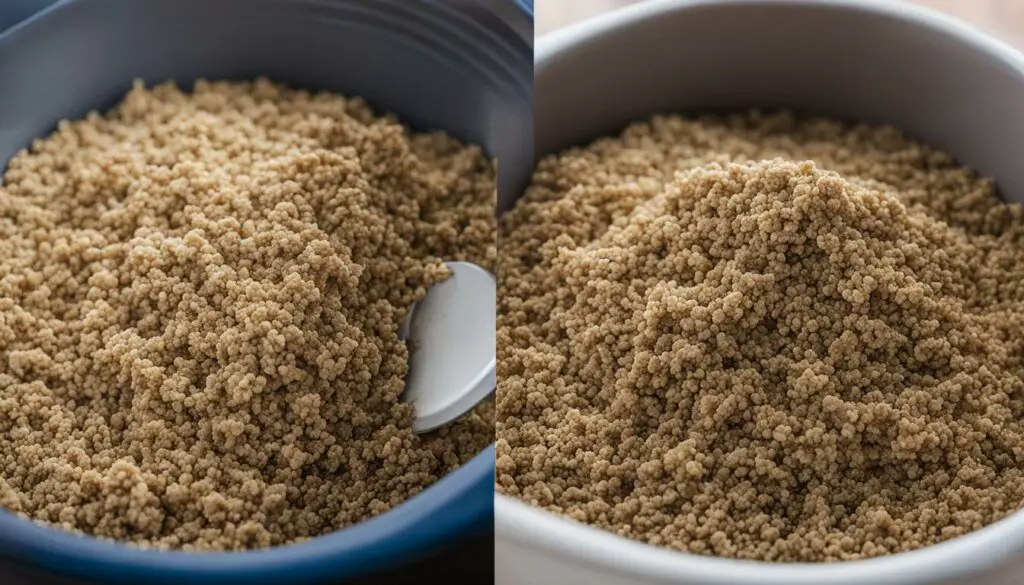
Key Considerations for Choosing Cat Litter:
- Individual cat preferences and needs
- Allergies or sensitivities
- Respiratory issues
- Waste management
- Desired level of maintenance
- Cleaning convenience
- Odor control
- Environmental impact
- Personal lifestyle and routine
Understanding these considerations and evaluating the pros and cons of clumping and non-clumping cat litter will help you make an informed decision for your furry companion. Remember, a comfortable and inviting litter box environment is essential for your cat’s well-being, so choose wisely!
Transitioning Between Litter Types
When transitioning between clumping and non-clumping cat litter, it is important to do so gradually to minimize any potential stress or aversion for your feline friend. Sudden changes in litter type can be disruptive and may cause cats to avoid using the litter box altogether. By following a few simple steps, you can help your cat adjust to the new litter type smoothly and without any issues.
The key to a successful transition is a gradual change. Start by mixing a small amount of the new litter with the old litter in the litter box. This allows your cat to become familiar with the scent and texture of the new litter while still having the comfort of the familiar litter. Over the course of several days or weeks, gradually increase the ratio of the new litter to the old litter until you have completely transitioned to the new litter type.
Observing your cat’s behavior during the transition is crucial. Keep an eye out for any signs of discomfort or reluctance to use the litter box. If your cat shows signs of distress, you may need to slow down the transition process and give them more time to adjust. Providing extra litter boxes throughout your home during the transition period can also help ensure that your cat always has access to an appropriate place to relieve themselves.
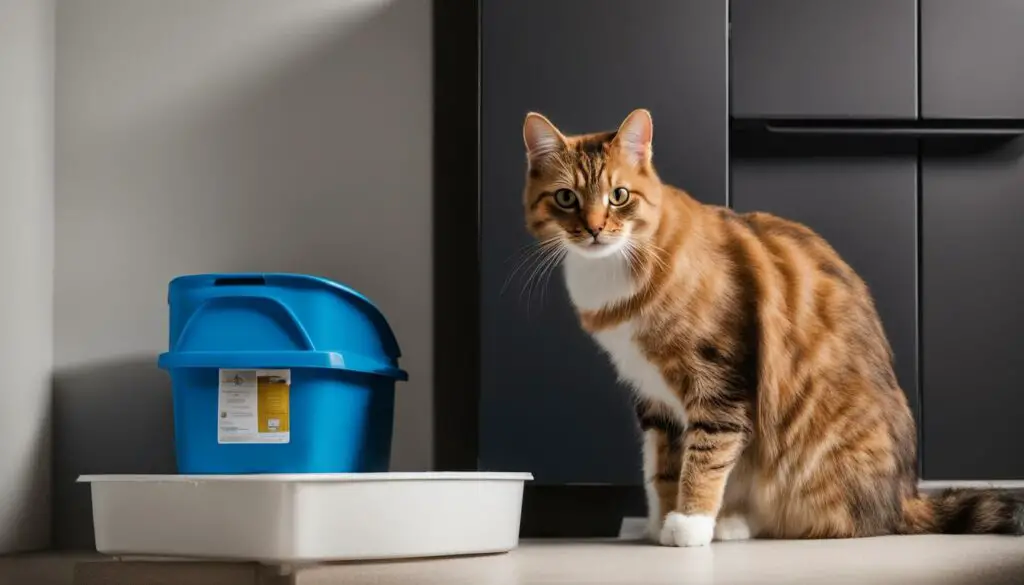
“Transitioning between clumping and non-clumping cat litter doesn’t have to be stressful for your cat. By taking it slow and giving them time to adjust, you can make the transition a smooth and positive experience. Remember to always observe your cat’s behavior and make any necessary adjustments to ensure their comfort and well-being.”
It is worth noting that some cats may take longer to adjust to a new litter type than others. Patience and consistency are key during this process. Avoid switching back and forth between different types of litter, as this can further confuse your cat. Once you have successfully transitioned to a new litter type, continue to monitor your cat’s litter box habits to ensure they are comfortable and using the litter box regularly.
By following these gradual transition methods, you can help your cat adapt to a new litter type without unnecessary stress or discomfort. Remember to monitor their behavior and make any necessary adjustments along the way. Providing a clean, comfortable, and inviting litter box environment is essential to promoting your cat’s overall well-being and ensuring proper litter box usage.
Maintaining a Clean and Inviting Litter Box
Keeping your cat’s litter box clean and hygienic is essential for their health and well-being. A clean litter box not only helps to prevent unpleasant odors but also encourages your cat to consistently use the litter box. Here are a few key tips to ensure a clean and inviting litter box environment.
Regular Scooping of Waste
The first step in maintaining a clean litter box is to regularly scoop out solid waste. This prevents the accumulation of odor-causing bacteria and ensures that your cat has a fresh and clean area to do their business. Depending on the number of cats you have, scooping once or twice a day is generally recommended. Remember to dispose of the waste in a sealed bag or appropriate waste receptacle.
Frequent Litter Changes
In addition to scooping solid waste, it’s important to change the litter regularly to maintain cleanliness. How often you change the litter depends on the type of litter you use and your cat’s waste habits. Non-clumping litter may require more frequent complete changes, while clumping litter can be topped up as needed. Always follow the manufacturer’s guidelines for litter change frequency to ensure optimal hygiene.
Proper Litter Box Placement
The location of the litter box plays a crucial role in maintaining cleanliness. Choose a quiet and private area for the litter box where your cat feels comfortable and undisturbed. Avoid placing it near their food and water dishes, as cats prefer to keep their bathroom area separate from their feeding area. This will help promote consistent litter box usage and minimize accidents outside the box.
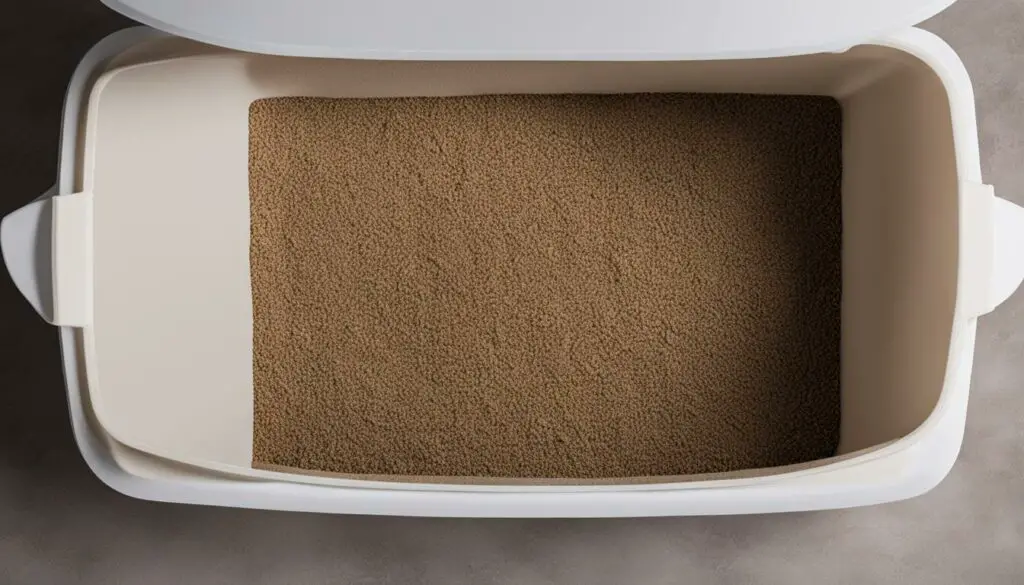
By following these simple steps, you can ensure that your cat’s litter box remains clean and inviting. Regular scooping of waste, frequent litter changes, and proper litter box placement are key factors in maintaining a hygienic environment that promotes your cat’s comfort and well-being. Remember, a clean litter box is essential for a happy and healthy feline friend.
Conclusion
When it comes to choosing between clumping and non-clumping cat litter, there are several factors to consider. Making the right decision requires evaluating factors such as granule type, maintenance requirements, odor control, and environmental impact.
Clumping cat litter offers the advantages of easy cleanup, effective odor control, and long-lasting performance. On the other hand, non-clumping cat litter requires less maintenance and may provide a more natural and eco-friendly option.
Ultimately, the decision should be based on your cat’s preferences, your lifestyle, and your desire for a clean and comfortable litter box experience. Consider your cat’s needs and any specific considerations, such as allergies or medical conditions, in order to provide the best choice for your feline friend.
By carefully evaluating these factors, you can make an informed decision that promotes your cat’s comfort and encourages consistent litter box usage. Remember, every cat is unique, so finding the right cat litter is a personal choice that ensures a clean and inviting litter box environment.
FAQ
What is the difference between clumping and non-clumping cat litter?
Clumping cat litter forms solid clumps, making it easy to scoop out and remove solid waste, while non-clumping litter does not form clumps and may require more frequent complete changes.
What are the advantages of clumping cat litter?
Clumping cat litter is highly absorbent, effectively controlling odors, and tends to last longer than non-clumping alternatives, providing a cost-effective solution for cat owners.
What are the benefits of non-clumping cat litter?
Non-clumping cat litter is often made from natural materials, requires less maintenance, and offers more environmentally friendly options. However, it may require more frequent complete changes to prevent bacterial growth and control odor.
How do I choose the right type of cat litter?
Consider factors such as synthetic or natural materials, granule type (clay, silica gel, wood pellets, recycled paper), and your cat’s preferences and your own cleaning routine when deciding which type of litter to use.
How do clumping and non-clumping cat litters control odors?
Clumping litter forms solid clumps that encapsulate odor-causing substances, while non-clumping litter may rely on antimicrobial properties to prevent bacterial and fungal growth and minimize odor.
Do clumping and non-clumping cat litters track or produce dust?
Both clumping and non-clumping litters can have options for low tracking and dust-free properties. Synthetic litters tend to have lower tracking, while natural alternatives may be preferred for their environmentally friendly attributes.
What are the environmental considerations when choosing cat litter?
Some cat owners may prefer biodegradable or flushable options to reduce waste. Non-clumping litters made from natural materials like corn, wheat, pine, coconut, or grass can be more sustainable alternatives to synthetic options.
Can cat litter cause allergies or sensitivities?
Some cats may have sensitivities or allergies to certain scents or materials used in cat litter. Hypoallergenic options, both clumping and non-clumping, can be beneficial for cats with respiratory issues or sensitive skin.
How do clumping and non-clumping cat litters manage urine and feces?
Clumping cat litter is particularly effective at managing urine, as it forms solid clumps that are easy to remove. Non-clumping litters may require more frequent scooping to manage both urine and feces efficiently.
What are the long-term considerations for cat litter?
The longevity of cat litter can impact the overall maintenance required. Clumping cat litter tends to last longer before needing a complete change, while non-clumping litter may require more frequent replacements. Regular scooping and cleaning are necessary for both types to prevent bacterial growth and promote good litter box hygiene.
How do I make the right choice between clumping and non-clumping cat litter?
Consider the pros and cons of each type based on factors such as cleaning convenience, odor control, environmental impact, cat preferences, and your own lifestyle. Make an informed decision that aligns with your cat’s needs and allows for easy cleanup and a comfortable litter box experience.
How do I transition between clumping and non-clumping cat litter?
If you decide to switch between clumping and non-clumping cat litter, a gradual transition is recommended. Start by mixing small amounts of the new litter with the old one, gradually increasing the new litter ratio. This allows your cat to adjust to the new litter type without causing unnecessary stress or aversion.
How do I maintain a clean and inviting litter box?
Regardless of the type of litter you choose, maintaining a clean and inviting litter box is essential. Regularly scoop out solid waste, change litter as needed, and ensure the litter box is in a quiet and private location. Providing a clean litter box environment encourages consistent and comfortable litter box usage.

